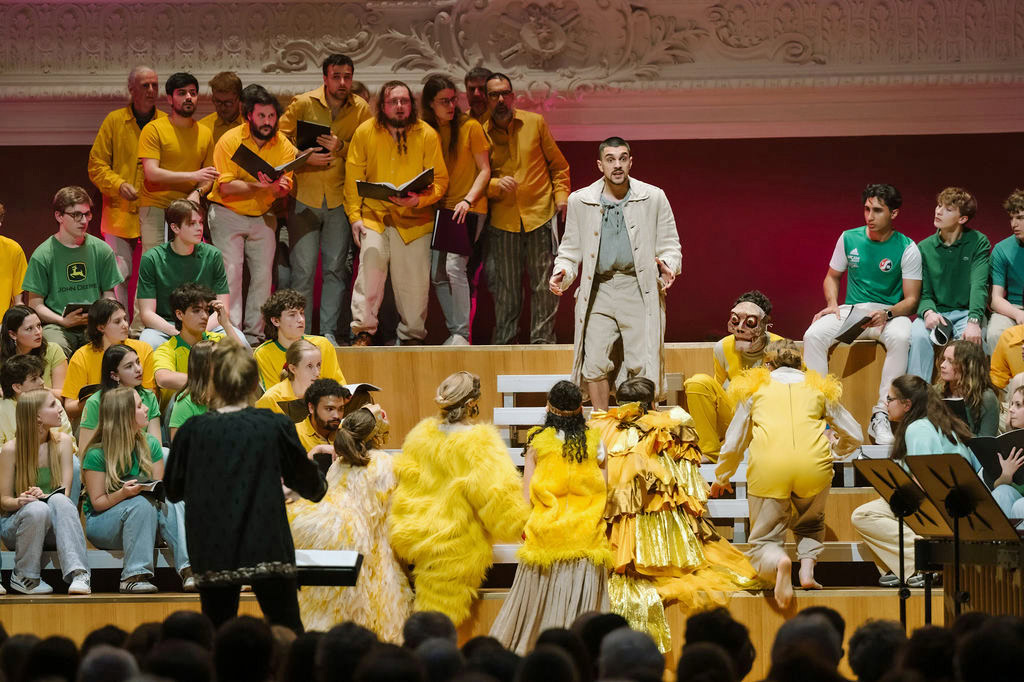Mario Venzago's violin concerto as a bio-piece?
For his farewell concert as chief conductor of the Bern Symphony Orchestra, Mario Venzago programmed his violin concerto as a world premiere. The work has autobiographical features, but should not be interpreted as a private musical diary.

The word "bio-piece", an analogy to the English abbreviation "biopic" for a film biography, is not yet very common in music literature and journalism. This could be due to the fact that the subject itself has never had an easy time of it. The question of whether autobiographical composition is permissible or even feasible has often been discussed, criticized and even ridiculed in the history of music. Richard Strauss, who would later work in this direction himself, recommended, for example, that a "menu" should be set to music instead.
Is the "success" of such confessional music only possible if the composer himself is well-known enough and the fate depicted is drastic and harsh enough? The idea seems to lead in the wrong direction. Apart from the somewhat questionable category of the "success" of a work of art, its quality must result more from the "how", the facture, than from the "what", the extra-musical content. And doesn't every piece of music embody a piece of life (standing on its own) in the broadest sense, which communicates itself to the listener and can and should awaken subjective associations in them? Establishing references to real historical facts and using biographical references does not usually seem necessary. Many composers later erased or negated their own relevant information.
Musical speaking in a solo concert
Autobiographical composition is not bound to specific forms. Richard Wagner's Tannhäuser bears strong autobiographical traits, but also Richard Strauss' Metamorphoses for 23 solo strings, Hector Berlioz' Symphonie fantastiqueBedřich Smetana's first string quartet and many other works contain autobiographical motifs in explicit or concealed form. In this context, Mario Venzago's decision to write a solo concerto seems simple, clear and logical, as it is unmistakably an "I" speaking musically, dealing with an immediate sound environment.
At almost 73 years of age, conductor Mario Venzago, who has spent his life surprising, touching and inspiring his audiences, is once again showing a completely new side. For his farewell concert with the Bern Symphony Orchestra, of which he was chief conductor for eleven years, he will premiere his own violin concerto with the great violinist Soyoung Yoon at the Casino Bern on June 24/25, 2021. Pandemic laws are still in force, but the strict government restrictions will be lifted exclusively for this concert and 600 spectators will be admitted for the first time. As a result, the hall is well filled with a music-hungry audience that receives Venzago's exquisite program (almost exclusively 20th century Swiss composers, including three principal conductors of the Bern Symphony Orchestra) with great alertness, gratitude and frenetic applause.
Conducting life in five movements
The violin concerto comes at the end of the evening, after a movement ("Nachklang") from Fritz Brun's Seventh Symphony, the Orchestral Variations op. 20 by Paul Kletzki and the Symphonie liturgique by Arthur Honegger. A remarkable composition full of inner references; in particular, the Honegger symphony seems to have been the inspiration for the composition of the violin concerto. Technically, this is by far the most demanding work of the evening for the musicians.
The composition benefits from Venzago's 40 years of practical conducting experience: the result is fascinating, ever-changing orchestral colors and movements, a murderous yet perfectly violinistic solo part and a carefully crafted balance and transparency that provides insight into a multi-layered sound cosmos and imaginative structures. Mario Venzago, who is known as a cheerful, humorous person with a great talent for entertainment, presents his violin concerto to the audience as an autobiographical and very personal work that runs through just as many stages of his conducting life in five movements. It is therefore all the more surprising, even upsetting, that this "confession" as a whole is so deeply melancholy.
The tense first bars introduce a twelve-tone row that forms the basis of the work as an "I" theme. It soon turns into a series of recurring, horrific, unyielding beats, between which the solo violin writhes and struggles desperately as an individual. There is hardly any time to catch one's breath or linger, the forward movement seems like an unstoppable compulsion. Seemingly humorous allusions are heard, such as Schubert's Pigeon maillively tango and waltz sounds (for the "Bern" section). The cheerfulness has the same effect as in the originalPigeon mail, feigned. Two chromatic "ascents", inspired by Ludwig Hohl's Ascent, determine and bracket the concert for long stretches.
They are not walks. They are more like an arduous, violent upward push in tiny intermittent steps, accompanied by stone or low blows, sometimes even entire avalanches of rubble. The infinitely arduous ascent - probably a metaphor for an (artist's) career - thus becomes the general theme, and the piece's constants are drivenness and agony. Exposed to terrible, violent currents and helpless loneliness in icy "heights", the "I" of this musical narrative never reaches the summit. Only the two contemplations of a (desolate) mountain lake provide a point of calm - here the woodwinds accompany the solo violin in the highest register.
The violins are missing in this concerto; in the resulting void, the solo violin moves together with the concertmaster, who, according to Venzago, is supposed to be its "support and mountain guide". The loneliness does not diminish as a result; rather, one seems to perceive a doubling of the ego or its shadow. The only counterpart here is madness in the form of the mercilessly ringing cymbal antique, which the solo voice encounters as a soloist at times, and in the most succinct Shostakovich reminiscence, death also knocks briefly at the door on the woodblock. Triumph, which could also be part of such a "curriculum vitae", is nowhere to be found. The longing that the Pigeon mail-quote - what is it aimed at? We don't find out, perhaps because we don't know the private enunciations of the work; we hear slightly moldy, chromatically colored thirds and sixths like ciphers of bitter self-irony.
The pain of life in overwhelming sounds
By making the artist's career the main idea of this musical biography, it seems to evoke a certain image of man that has significantly shaped our era and probably continues to do so. The performance ethicist, the person who directs his entire endeavors towards his personal performance and its successes, appears here in the special form of the artist who devotes his life to music. In this profession, perfection is a must, the "marriage" indissoluble, the associated suffering unavoidable. Even if the Christian faith is obviously alluded to as a possibility of salvation, e.g. in the form of a reminiscence of the hermit's Salve Regina, the words of St. Peter "and wept bitterly" or the corresponding melodic paraphrase from the St. John Passion, interwoven with the twelve-tone row that defines the work, is the final word of the composition.
The realization of a mistake that cannot be undone? A missed life even? At the same time, a homage to the greatest of all composers for Venzago, Johann Sebastian Bach? The pain of this main and final thought is communicated with great intensity. Only in the long echo of the final bars could there be a hint of consolation. The hope of the piece seems to be that this message of life becomes audible, even understandable. It is an admirable compositional achievement that the symbolism of the sound and the musical language communicate themselves directly and awaken the most diverse associations, and that the pain shines in such overwhelming musical colors and sounds.
It would be misleading to draw conclusions about the composer's mental state from the musical depiction of such life pain. A bio-piece is not a private diary. It may be based on a personal statement, and the personal aspect is strongly present when the composer himself conducts and refers to it as a moderator. Nevertheless, the personal statement, every autobiographical motif, is cast in sound, in form, naturally stylized. It takes on a life of its own to create something new that takes the initial idea to other levels. The suffering of the self becomes the human condition. The music evokes not only the suffering itself, but also the empathic view of it. This process, the transformation of what has possibly been experienced into something valid, can also be read as a metaphor for the genesis of a work in the "Ascent" passages. The term bio-piece thus merely describes the external framework of a composition and a special type of source material. Other aspects are decisive for the processing, the "how" and its interpretation.
The score and material for Mario Venzago's violin concerto are published by Universal Edition Wien.
Dorothea Krimm
... is a musicologist and manages the library of the Bühnen Bern.








